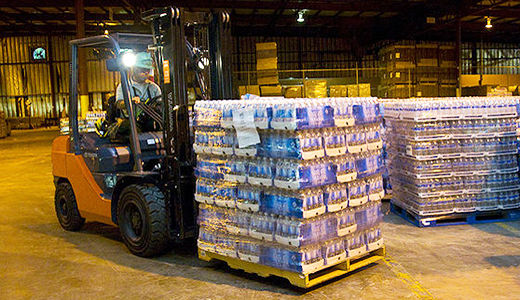
JOLIET, Ill. (PAI) – Workers in trans-shipment warehouses – an increasing part of the U.S. economy – are low paid, with no benefits for most, and four of every five are temps who are forced to move from warehouse to warehouse when they’d really like permanent jobs, a recent report says.
The report, “Bad Jobs in Goods Movement: Warehouse Work in Will County,” by the University of Illinois-Chicago and Warehouse Workers Jobs for Justice, paints a picture of exploitation of a mostly minority labor force in the logistics field.
The report focused on warehouses in Will County, Ill., south and southwest of Chicago. The area has become a major warehouse and trans-shipment point for national shippers, retailers and wholesalers, due to increasing containerization of goods and use of multiple ways to ship them to market, called intermodal transportation.
Will County became a center of such intermodal commerce due to the Chicago area’s confluence of six major railroads, several interstate highways, the city’s port and the desire of cross-country shippers to avoid Chicago’s congestion. There are similar warehouse districts, with similar conditions, outside Los Angeles and New York.
Will County warehouses are a jobs magnet, employing more than 200,000 workers in 88 million square feet of space. Working conditions, based on the report’s survey of 150 warehouses and in-depth interviews with more than 300 workers, show:
- Four of every five warehouse workers are temps, and their median hourly wage was $9. As a result, 63 percent of Will County warehouse workers earned wages below the federal poverty line – including one percent earning less than the minimum wage.
- The median hourly wage for full-time non-temp warehouse workers is $12.46, or just under $26,000 yearly. That covers workers from stock clerks ($9.28 hourly) and packers ($9.59) to shipping clerks ($14.55). But that’s only 19 percent of warehouse workers.
- Temp warehouse workers toil only for a few weeks or months at a time in each warehouse, then are let go and transferred to another, the report found. As a result, they also are ineligible for benefits, and warehouse owners – by hiring through the temp agencies – don’t have to pay workers’ comp for them.
They also stay temps: 63 percent worked at warehouses as temps beyond the usual 3-month period where temps, in other occupations, are hired into permanent jobs.
One of every seven of the temp warehouse workers told researchers that at some point they had shown up for work, toiled in the warehouses, and not gotten paid.
An overwhelming majority of the warehouse workers are minority-group men. Three-fourths are male, 48 percent are African American, 36 percent are Hispanic or Latino, three percent are mixed race and two percent are Arab, Asian or Native American. And 40 percent reported discrimination on the job, with race as the prime cause – and speaking out for workers’ rights as cause number two.
Harkening back to the days of sweatshops, researchers found many warehouse workers, particularly loaders and unloaders, were paid by the piece. Unloaders were paid by the truck, with a wage of $32-$80 per truck – depending on the rig’s size – divided between two and four workers, regardless of how long it took them to unload it.
“This rate is constant regardless of the time necessary to complete a load, which meant between one and three loads during a normal work day,” researchers reported. “Workers complained that when a load came in before the end of a shift, unloaders were expected to stay until it was finished, sometimes up to seven hours later.”
Benefits were virtually non-existent. Only five percent got paid sick leave, eight percent got paid vacation and four percent had health insurance.
Almost one in every five (18 percent) of warehouse workers were injured on the job, but more than a third of them did not report the injuries. That’s because 29 percent of those who did were fired or disciplined, and only 28 percent were covered by workers’ comp.
The report said federal data show the conditions found in the Will County warehouses could equally apply at other major warehouse concentrations nationwide, such as those outside Los Angeles and New York City.
For example, hand laborers, freight, stock and material movers in warehouses, who in Will County make $11.06 hourly, account for 19 percent of all temp workers in the U.S., according to Bureau of Labor Statistics. Warehouse packers are another 5 percent of all temps nationwide.
The report, presented at a session that included Mark Meinster of the United Electrical Workers, recommended creating pathways to stable employment for the warehouse workers. It also said taxpayer support of warehouse operations – through tax breaks for development – should be linked to creation of full-time permanent jobs.
And the report also recommended enacting laws mandating living-wage jobs, stronger enforcement of existing wage and hour laws, and giving warehouse workers the right to organize. As temps, they are denied the right to unionize.
Additional reporting from The Will County Labor Record. Image courtesy FEMA Photo Library and is in the public domain.










